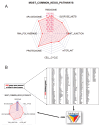Cancer Cell's Achilles Heels: Considerations for Design of Anti-Cancer Drug Combinations
- PMID: 39769257
- PMCID: PMC11676151
- DOI: 10.3390/ijms252413495
Cancer Cell's Achilles Heels: Considerations for Design of Anti-Cancer Drug Combinations
Abstract
Loss of function screens using shRNA (short hairpin RNA) and CRISPR (clustered regularly interspaced short palindromic repeats) are routinely used to identify genes that modulate responses of tumor cells to anti-cancer drugs. Here, by integrating GSEA (Gene Set Enrichment Analysis) and CMAP (Connectivity Map) analyses of multiple published shRNA screens, we identified a core set of pathways that affect responses to multiple drugs with diverse mechanisms of action. This suggests that these pathways represent "weak points" or "Achilles heels", whose mild disturbance should make cancer cells vulnerable to a variety of treatments. These "weak points" include proteasome, protein synthesis, RNA splicing, RNA synthesis, cell cycle, Akt-mTOR, and tight junction-related pathways. Therefore, inhibitors of these pathways are expected to sensitize cancer cells to a variety of drugs. This hypothesis was tested by analyzing the diversity of drugs that synergize with FDA-approved inhibitors of the proteasome, RNA synthesis, and Akt-mTOR pathways. Indeed, the quantitative evaluation indicates that inhibitors of any of these signaling pathways can synergize with a more diverse set of pharmaceuticals, compared to compounds inhibiting targets distinct from the "weak points" pathways. Our findings described here imply that inhibitors of the "weak points" pathways should be considered as primary candidates in a search for synergistic drug combinations.
Keywords: CMAP; GSEA; drug combination; shRNA screening; signaling pathway; synergy.
Conflict of interest statement
The authors declare no conflict of interest.
Figures


Similar articles
-
Kinome RNAi Screens Reveal Synergistic Targeting of MTOR and FGFR1 Pathways for Treatment of Lung Cancer and HNSCC.Cancer Res. 2015 Oct 15;75(20):4398-406. doi: 10.1158/0008-5472.CAN-15-0509. Epub 2015 Sep 10. Cancer Res. 2015. PMID: 26359452 Free PMC article.
-
Synergistic Effects of Combination Therapy with AKT and mTOR Inhibitors on Bladder Cancer Cells.Int J Mol Sci. 2020 Apr 18;21(8):2825. doi: 10.3390/ijms21082825. Int J Mol Sci. 2020. PMID: 32325639 Free PMC article.
-
Vertical blockade of the IGFR- PI3K/Akt/mTOR pathway for the treatment of hepatocellular carcinoma: the role of survivin.Mol Cancer. 2014 Jan 3;13:2. doi: 10.1186/1476-4598-13-2. Mol Cancer. 2014. PMID: 24387108 Free PMC article.
-
Crosstalk between hedgehog and other signaling pathways as a basis for combination therapies in cancer.Cancer Treat Rev. 2014 Jul;40(6):750-9. doi: 10.1016/j.ctrv.2014.02.003. Epub 2014 Feb 24. Cancer Treat Rev. 2014. PMID: 24613036 Review.
-
PI3K/Akt/mTOR and Ras/Raf/MEK/ERK signaling pathways inhibitors as anticancer agents: Structural and pharmacological perspectives.Eur J Med Chem. 2016 Feb 15;109:314-41. doi: 10.1016/j.ejmech.2016.01.012. Epub 2016 Jan 12. Eur J Med Chem. 2016. PMID: 26807863 Review.
References
-
- Jardim D.L., De Melo Gagliato D., Nikanjam M., Barkauskas D.A., Kurzrock R. Efficacy and Safety of Anticancer Drug Combinations: A Meta-Analysis of Randomized Trials with a Focus on Immunotherapeutics and Gene-Targeted Compounds. Oncoimmunology. 2020;9:1710052. doi: 10.1080/2162402X.2019.1710052. - DOI - PMC - PubMed
MeSH terms
Substances
LinkOut - more resources
Full Text Sources
Medical
Molecular Biology Databases
Miscellaneous

